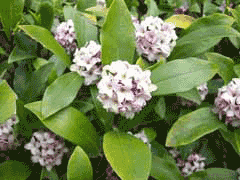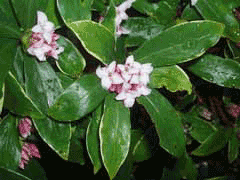 |
|
http://commons.wikimedia.org/wiki/User:Miya |
 |
| http://commons.wikimedia.org/wiki/User:Herbythyme |
Translate this page:
Summary
Bloom Color: Pink, Purple.
Main Bloom Time: Early winter, Late winter, Mid winter. Form: Rounded.
Physical Characteristics

 Daphne odora is an evergreen Shrub growing to 1.5 m (5ft) by 1.5 m (5ft) at a slow rate.
Daphne odora is an evergreen Shrub growing to 1.5 m (5ft) by 1.5 m (5ft) at a slow rate.
See above for USDA hardiness. It is hardy to UK zone 7. It is in leaf all year, in flower from January to March. The species is hermaphrodite (has both male and female organs) and is pollinated by Bees, flies, Lepidoptera (Moths & Butterflies).
Suitable for: medium (loamy) and heavy (clay) soils and prefers well-drained soil. Suitable pH: mildly acid and neutral soils. It can grow in semi-shade (light woodland) or no shade. It prefers moist soil.
UK Hardiness Map
US Hardiness Map
Synonyms
D. indica. Hort. D. japonica. Paxton. D. sinensis.
Plant Habitats
Woodland Garden Dappled Shade; Shady Edge; Ground Cover;
Edible Uses
References More on Edible Uses
Medicinal Uses
Plants For A Future can not take any responsibility for any adverse effects from the use of plants. Always seek advice from a professional before using a plant medicinally.
Anodyne Antiphlogistic Antispasmodic Depurative Ophthalmic
The flowers and the stems are anodyne, antiphlogistic, antispasmodic, depurative and ophthalmic[147]. A decoction is used in the treatment of backache, myalgia, skin diseases, poor vision etc[147, 218]. A decoction of the leaves is used in the treatment of laryngitis and sore throats[218]. A decoction of the roots and leaves is used in the treatment of sore throat and caked breast[218].
References More on Medicinal Uses
The Bookshop: Edible Plant Books
Our Latest books on Perennial Plants For Food Forests and Permaculture Gardens in paperback or digital formats.

Edible Tropical Plants
Food Forest Plants for Hotter Conditions: 250+ Plants For Tropical Food Forests & Permaculture Gardens.
More

Edible Temperate Plants
Plants for Your Food Forest: 500 Plants for Temperate Food Forests & Permaculture Gardens.
More

More Books
PFAF have eight books available in paperback and digital formats. Browse the shop for more information.
Shop Now
Other Uses
Pot-pourri
The flowers are very fragrant, they are put in sachets and used for pot-pourri. They are also used to perfume water[46, 61]. The cultivar 'Aureo-marginata' can be used as a ground cover when planted about 1 metre apart each way[208].
Special Uses
Ground cover Scented Plants
References More on Other Uses
Cultivation details
Landscape Uses:Border, Container, Foundation, Ground cover, Massing, Rock garden, Specimen. Prefers a cool, lime-free well-drained friable soil[1] and some shelter from cold winds[166]. Succeeds in full sun or semi-shade[219]. This species is not generally hardy in Britain[1] but succeeds outdoors in Devon and Cornwall[11], tolerating temperatures down to about -5°c[200]. The cultivar 'Aureo-marginata' is hardy to about -13°c when grown in a very well-drained soil and it succeeds outdoors at Wisley[200]. Plants can be difficult to establish[208]. A very ornamental plant, a number of named forms have been developed for their ornamental value[182]. The flowers are powerfully fragrant with a spicy undertone[245]. Plants seldom set fruit in British gardens[219]. Plants are resentful of root disturbance and should be planted into their permanent positions as soon as possible[188]. This species is often affected by virus diseases. Some virus-free clones have been produced, their name is normally followed by the letters FKV (free of all known virus)[184]. Special Features:
Not North American native, All or parts of this plant are poisonous, Fragrant flowers, Attractive flowers or blooms.
References Carbon Farming Information and Carbon Sequestration Information
Temperature Converter
Type a value in the Celsius field to convert the value to Fahrenheit:
Fahrenheit:
The PFAF Bookshop
Plants For A Future have a number of books available in paperback and digital form. Book titles include Edible Plants, Edible Perennials, Edible Trees,Edible Shrubs, Woodland Gardening, and Temperate Food Forest Plants. Our new book is Food Forest Plants For Hotter Conditions (Tropical and Sub-Tropical).
Shop Now
Plant Propagation
Seed - best sown in a greenhouse as soon as it is ripe with the pot sealed in a polythene bag to hold in the moisture. Remove this bag as soon as germination takes place[164]. The seed usually germinates better if it is harvested 'green' (when it has fully developed but before it dries on the plant) and sown immediately. Germination should normally take place by spring, though it sometimes takes a further year. Stored seed is more problematic. It should be warm stratified for 8 - 12 weeks at 20°c followed by 12 - 14 weeks at 3°c. Germination may still take another 12 months or more at 15°c[164]. Prick out the seedlings into individual pots as soon as they are large enough to handle. Grow the plants on in the greenhouse for their first winter and then plant out in spring after the last expected frosts. Cuttings of half-ripe wood, 7 - 10cm long at a node or with a heel, July/August in a frame. Layering
Other Names
If available other names are mentioned here
Native Range
Coming Soon
Weed Potential
Right plant wrong place. We are currently updating this section.
Please note that a plant may be invasive in one area but may not in your area so it's worth checking.
Conservation Status
IUCN Red List of Threatened Plants Status :

Growth: S = slow M = medium F = fast. Soil: L = light (sandy) M = medium H = heavy (clay). pH: A = acid N = neutral B = basic (alkaline). Shade: F = full shade S = semi-shade N = no shade. Moisture: D = dry M = Moist We = wet Wa = water.
Now available:
Food Forest Plants for Mediterranean Conditions
350+ Perennial Plants For Mediterranean and Drier Food Forests and Permaculture Gardens.
[Paperback and eBook]
This is the third in Plants For A Future's series of plant guides for food forests tailored to
specific climate zones. Following volumes on temperate and tropical ecosystems, this book focuses
on species suited to Mediterranean conditions—regions with hot, dry summers and cool, wet winters,
often facing the added challenge of climate change.
Read More
Expert comment
Author
Thunb.
Botanical References
11200
Links / References
For a list of references used on this page please go here
Readers comment
© 2010, Plants For A Future. Plants For A Future is a charitable company limited by guarantee, registered in England and Wales. Charity No. 1057719, Company No. 3204567.